2018 VOLKSWAGEN T-ROC isofix
[x] Cancel search: isofixPage 75 of 502
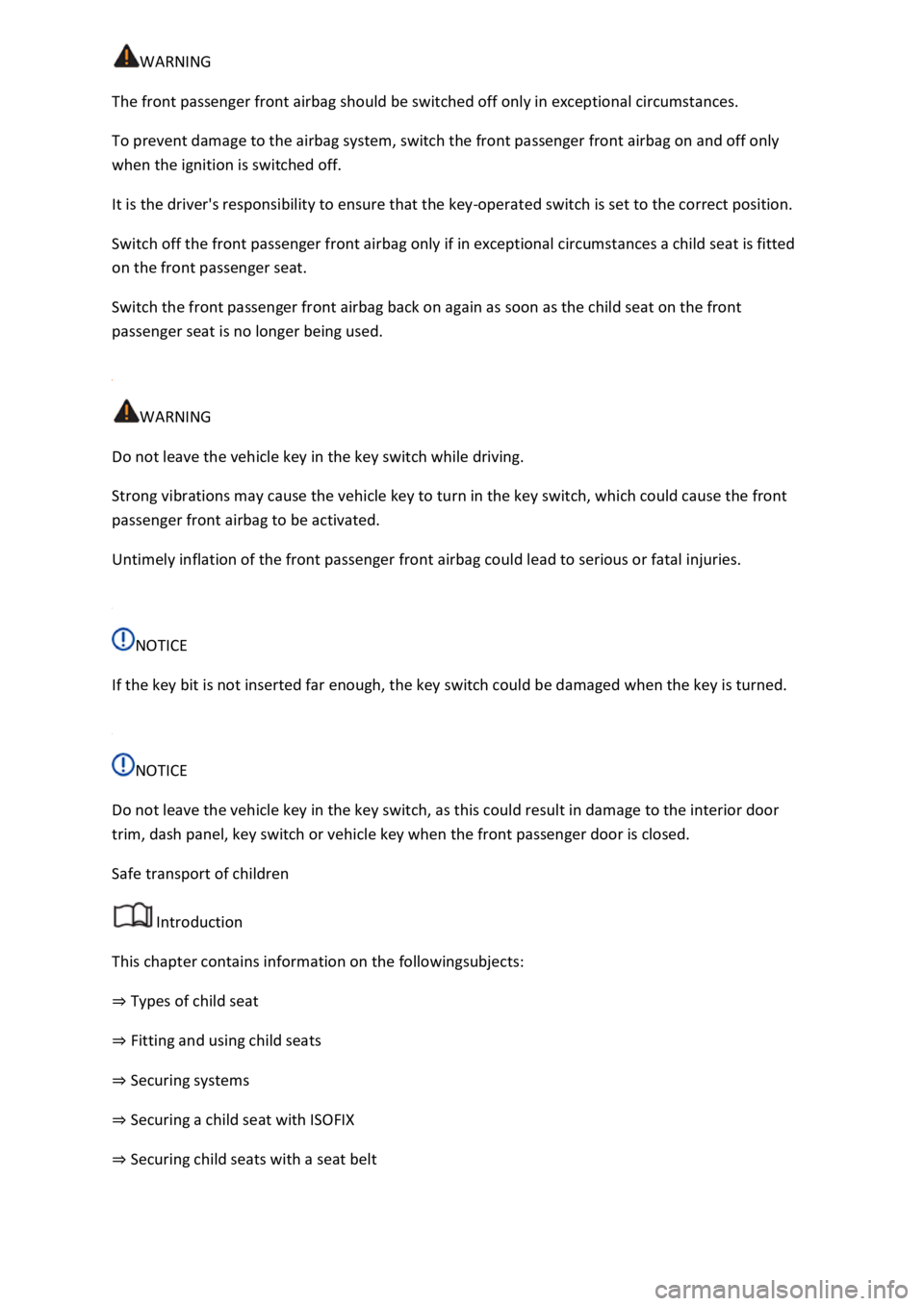
The front passenger front airbag should be switched off only in exceptional circumstances.
To prevent damage to the airbag system, switch the front passenger front airbag on and off only
when the ignition is switched off.
It is the driver's responsibility to ensure that the key-operated switch is set to the correct position.
Switch off the front passenger front airbag only if in exceptional circumstances a child seat is fitted
on the front passenger seat.
Switch the front passenger front airbag back on again as soon as the child seat on the front
passenger seat is no longer being used.
WARNING
Do not leave the vehicle key in the key switch while driving.
Strong vibrations may cause the vehicle key to turn in the key switch, which could cause the front
passenger front airbag to be activated.
Untimely inflation of the front passenger front airbag could lead to serious or fatal injuries.
NOTICE
If the key bit is not inserted far enough, the key switch could be damaged when the key is turned.
NOTICE
Do not leave the vehicle key in the key switch, as this could result in damage to the interior door
trim, dash panel, key switch or vehicle key when the front passenger door is closed.
Safe transport of children
Introduction
This chapter contains information on the followingsubjects:
Types of child seat
Fitting and using child seats
Securing systems
Securing a child seat with ISOFIX
Securing child seats with a seat belt
Page 78 of 502
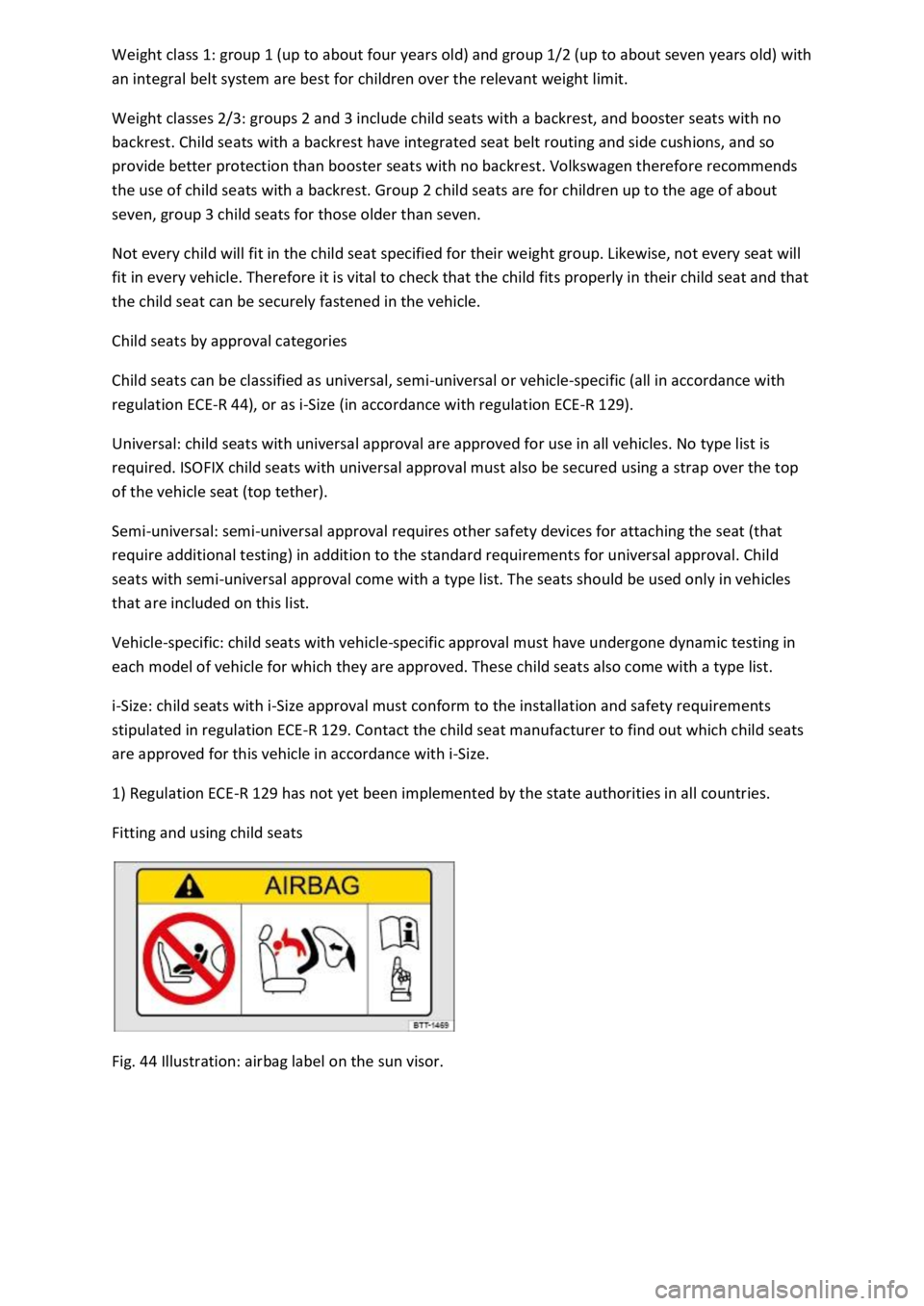
years old) and group 1/2 (up to about seven years old) with
an integral belt system are best for children over the relevant weight limit.
Weight classes 2/3: groups 2 and 3 include child seats with a backrest, and booster seats with no
backrest. Child seats with a backrest have integrated seat belt routing and side cushions, and so
provide better protection than booster seats with no backrest. Volkswagen therefore recommends
the use of child seats with a backrest. Group 2 child seats are for children up to the age of about
seven, group 3 child seats for those older than seven.
Not every child will fit in the child seat specified for their weight group. Likewise, not every seat will
fit in every vehicle. Therefore it is vital to check that the child fits properly in their child seat and that
the child seat can be securely fastened in the vehicle.
Child seats by approval categories
Child seats can be classified as universal, semi-universal or vehicle-specific (all in accordance with
regulation ECE-R 44), or as i-Size (in accordance with regulation ECE-R 129).
Universal: child seats with universal approval are approved for use in all vehicles. No type list is
required. ISOFIX child seats with universal approval must also be secured using a strap over the top
of the vehicle seat (top tether).
Semi-universal: semi-universal approval requires other safety devices for attaching the seat (that
require additional testing) in addition to the standard requirements for universal approval. Child
seats with semi-universal approval come with a type list. The seats should be used only in vehicles
that are included on this list.
Vehicle-specific: child seats with vehicle-specific approval must have undergone dynamic testing in
each model of vehicle for which they are approved. These child seats also come with a type list.
i-Size: child seats with i-Size approval must conform to the installation and safety requirements
stipulated in regulation ECE-R 129. Contact the child seat manufacturer to find out which child seats
are approved for this vehicle in accordance with i-Size.
1) Regulation ECE-R 129 has not yet been implemented by the state authorities in all countries.
Fitting and using child seats
Fig. 44 Illustration: airbag label on the sun visor.
Page 81 of 502
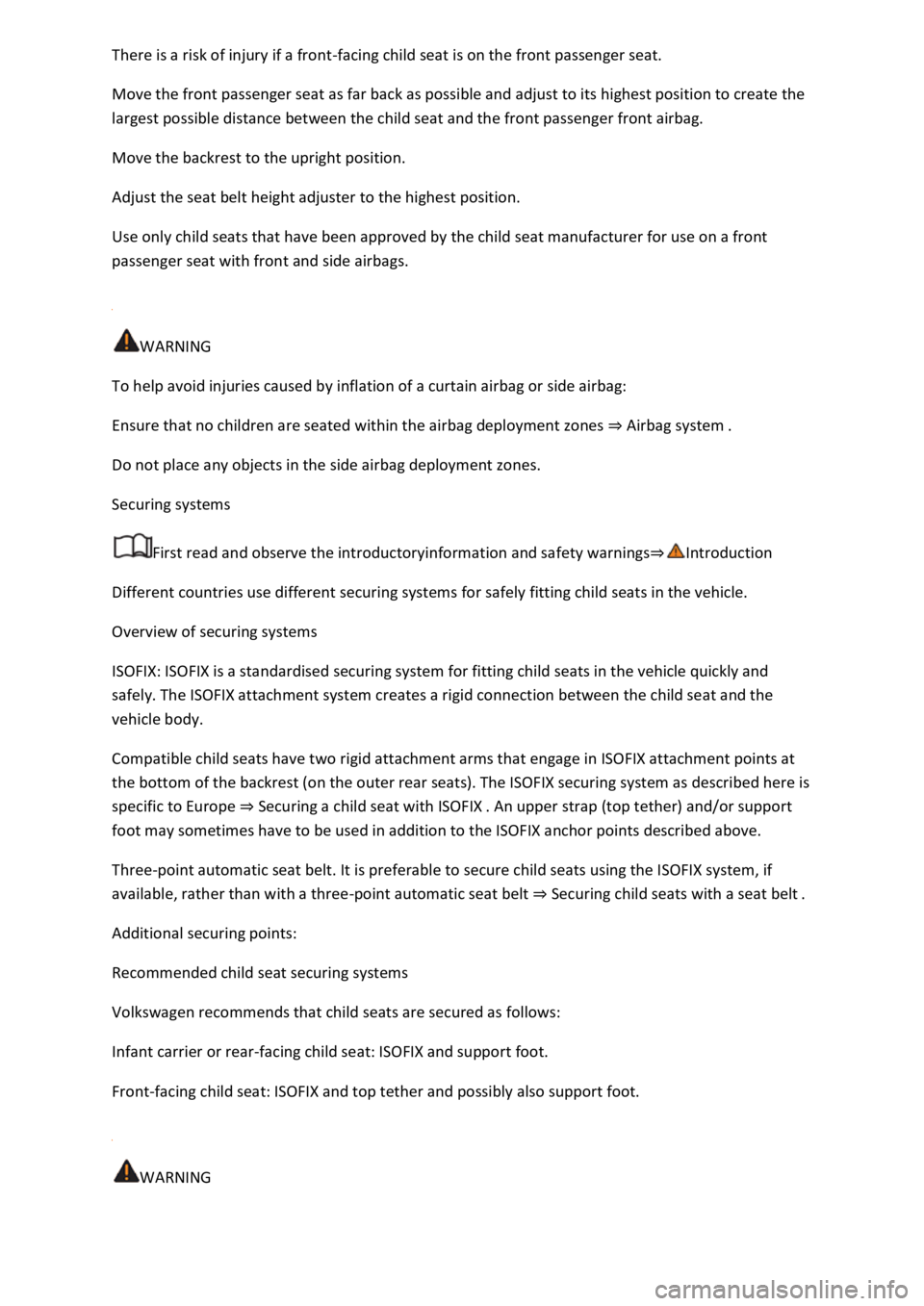
-facing child seat is on the front passenger seat.
Move the front passenger seat as far back as possible and adjust to its highest position to create the
largest possible distance between the child seat and the front passenger front airbag.
Move the backrest to the upright position.
Adjust the seat belt height adjuster to the highest position.
Use only child seats that have been approved by the child seat manufacturer for use on a front
passenger seat with front and side airbags.
WARNING
To help avoid injuries caused by inflation of a curtain airbag or side airbag:
Ensure that no children are seated within the airbag deployment zones Airbag system
Do not place any objects in the side airbag deployment zones.
Securing systems
First read and observe the introductoryinformation and safety warnings
Different countries use different securing systems for safely fitting child seats in the vehicle.
Overview of securing systems
ISOFIX: ISOFIX is a standardised securing system for fitting child seats in the vehicle quickly and
safely. The ISOFIX attachment system creates a rigid connection between the child seat and the
vehicle body.
Compatible child seats have two rigid attachment arms that engage in ISOFIX attachment points at
the bottom of the backrest (on the outer rear seats). The ISOFIX securing system as described here is
specific to Europe Securing a child seat with ISOFIX
foot may sometimes have to be used in addition to the ISOFIX anchor points described above.
Three-point automatic seat belt. It is preferable to secure child seats using the ISOFIX system, if
available, rather than with a three-point automatic seat belt Securing c
Additional securing points:
Recommended child seat securing systems
Volkswagen recommends that child seats are secured as follows:
Infant carrier or rear-facing child seat: ISOFIX and support foot.
Front-facing child seat: ISOFIX and top tether and possibly also support foot.
WARNING
Page 82 of 502
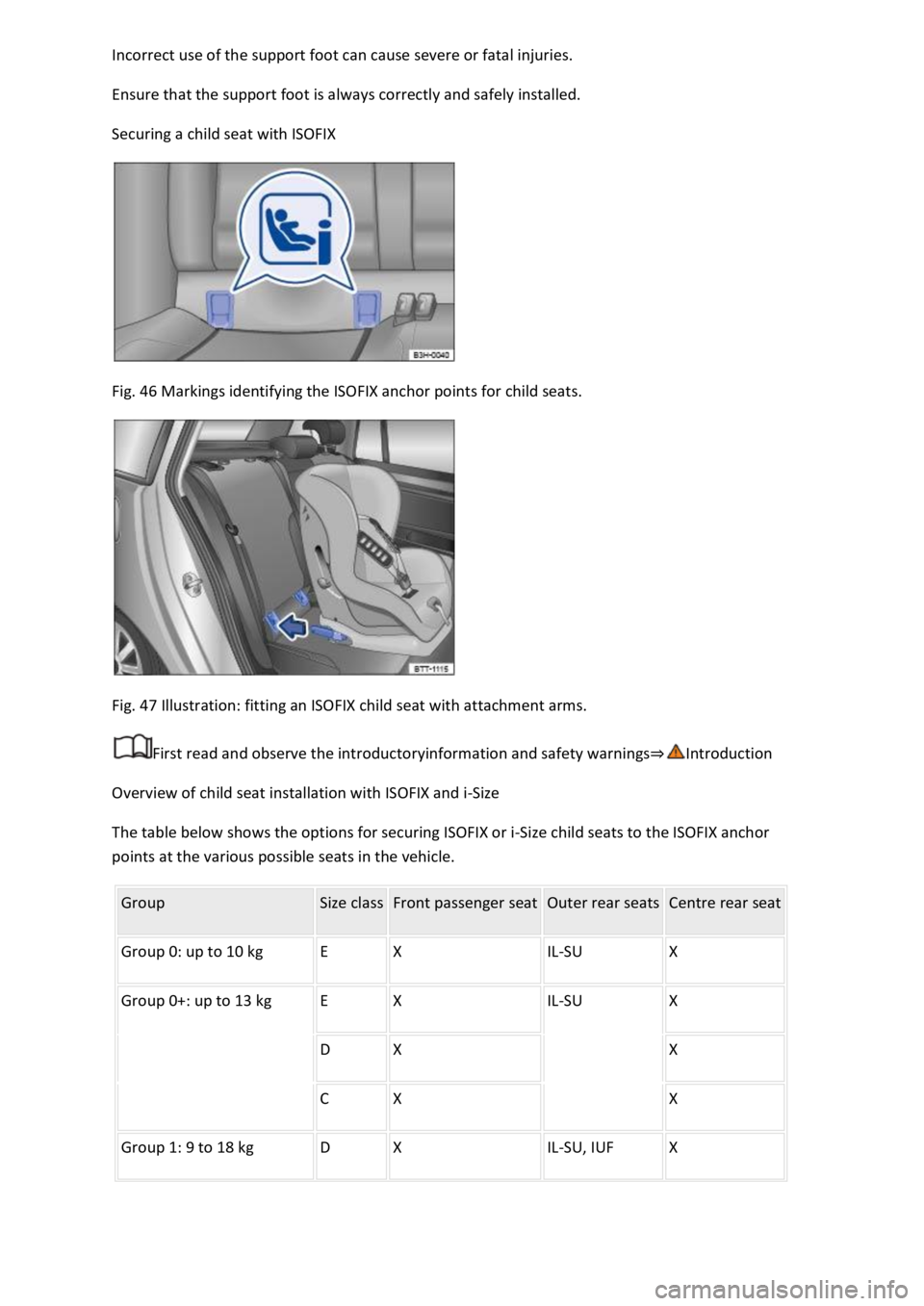
Ensure that the support foot is always correctly and safely installed.
Securing a child seat with ISOFIX
Fig. 46 Markings identifying the ISOFIX anchor points for child seats.
Fig. 47 Illustration: fitting an ISOFIX child seat with attachment arms.
First read and observe the introductoryinformation and safety warnings
Overview of child seat installation with ISOFIX and i-Size
The table below shows the options for securing ISOFIX or i-Size child seats to the ISOFIX anchor
points at the various possible seats in the vehicle.
Group Size class Front passenger seat Outer rear seats Centre rear seat
Group 0: up to 10 kg E X IL-SU X
Group 0+: up to 13 kg E X IL-SU X
D X X
C X X
Group 1: 9 to 18 kg D X IL-SU, IUF X
Page 83 of 502
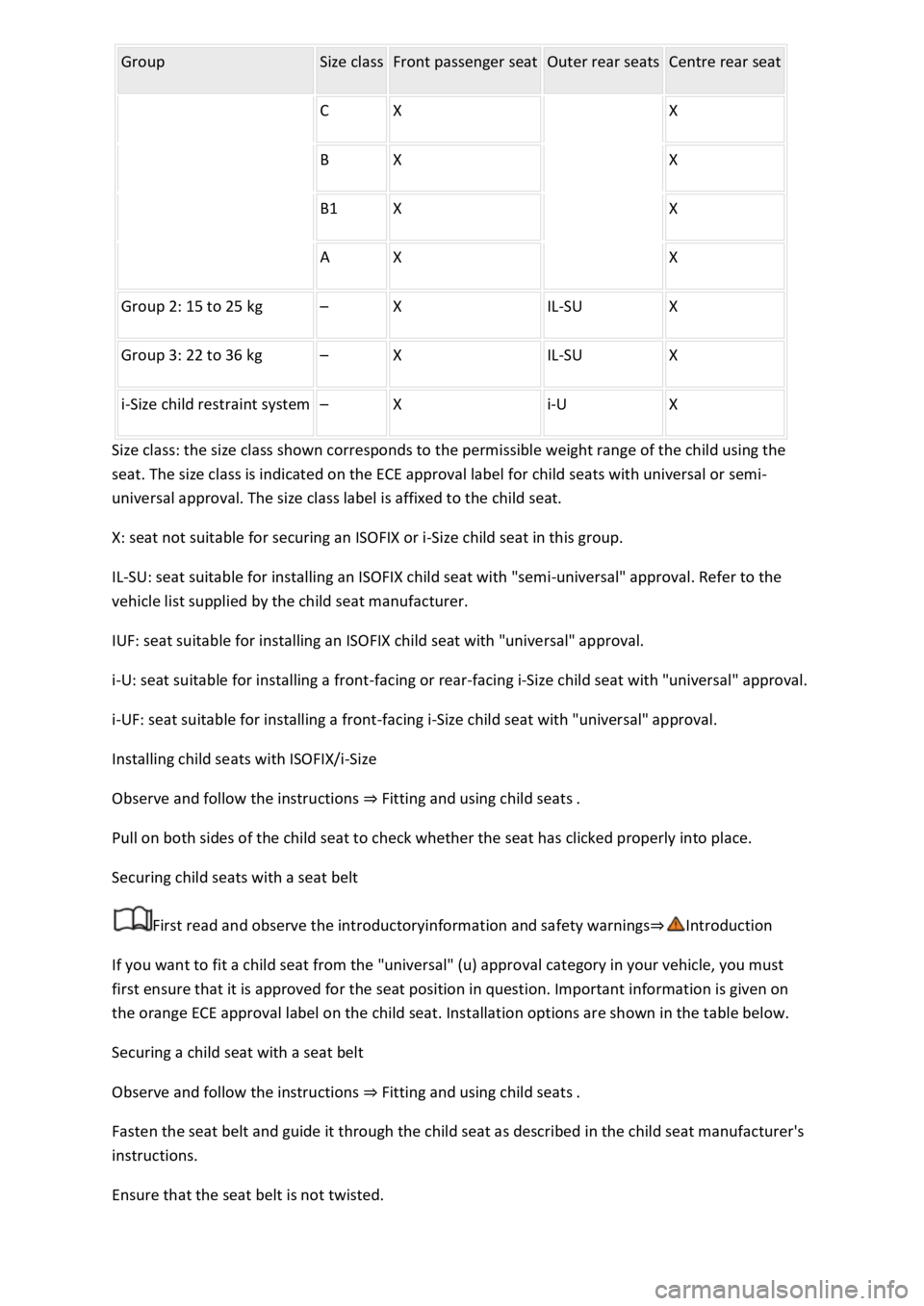
seat. The size class is indicated on the ECE approval label for child seats with universal or semi-
universal approval. The size class label is affixed to the child seat.
X: seat not suitable for securing an ISOFIX or i-Size child seat in this group.
IL-SU: seat suitable for installing an ISOFIX child seat with "semi-universal" approval. Refer to the
vehicle list supplied by the child seat manufacturer.
IUF: seat suitable for installing an ISOFIX child seat with "universal" approval.
i-U: seat suitable for installing a front-facing or rear-facing i-Size child seat with "universal" approval.
i-UF: seat suitable for installing a front-facing i-Size child seat with "universal" approval.
Installing child seats with ISOFIX/i-Size
Observe and follow the instructions Fitting and using child seats
Pull on both sides of the child seat to check whether the seat has clicked properly into place.
Securing child seats with a seat belt
First read and observe the introductoryinformation and safety warnings
If you want to fit a child seat from the "universal" (u) approval category in your vehicle, you must
first ensure that it is approved for the seat position in question. Important information is given on
the orange ECE approval label on the child seat. Installation options are shown in the table below.
Securing a child seat with a seat belt
Observe and follow the instructions Fitting and using child seats
Fasten the seat belt and guide it through the child seat as described in the child seat manufacturer's
instructions.
Ensure that the seat belt is not twisted.